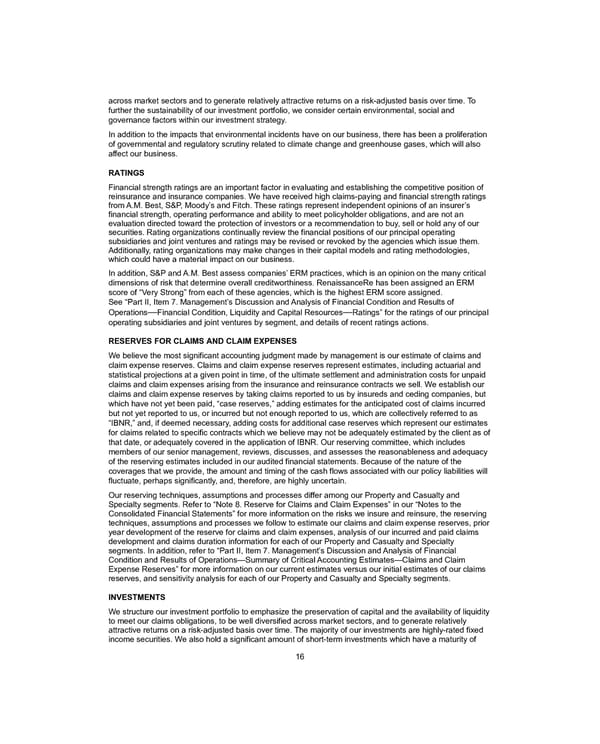across market sectors and to generate relatively attractive returns on a risk-adjusted basis over time. To further the sustainability of our investment portfolio, we consider certain environmental, social and governance factors within our investment strategy. In addition to the impacts that environmental incidents have on our business, there has been a proliferation of governmental and regulatory scrutiny related to climate change and greenhouse gases, which will also affect our business. RATINGS Financial strength ratings are an important factor in evaluating and establishing the competitive position of reinsurance and insurance companies. We have received high claims-paying and financial strength ratings from A.M. Best, S&P, Moody’s and Fitch. These ratings represent independent opinions of an insurer’s financial strength, operating performance and ability to meet policyholder obligations, and are not an evaluation directed toward the protection of investors or a recommendation to buy, sell or hold any of our securities. Rating organizations continually review the financial positions of our principal operating subsidiaries and joint ventures and ratings may be revised or revoked by the agencies which issue them. Additionally, rating organizations may make changes in their capital models and rating methodologies, which could have a material impact on our business. In addition, S&P and A.M. Best assess companies’ ERM practices, which is an opinion on the many critical dimensions of risk that determine overall creditworthiness. RenaissanceRe has been assigned an ERM score of “Very Strong” from each of these agencies, which is the highest ERM score assigned. See “Part II, Item 7. Management’s Discussion and Analysis of Financial Condition and Results of Operations — Financial Condition, Liquidity and Capital Resources — Ratings” for the ratings of our principal operating subsidiaries and joint ventures by segment, and details of recent ratings actions. RESERVES FOR CLAIMS AND CLAIM EXPENSES We believe the most significant accounting judgment made by management is our estimate of claims and claim expense reserves. Claims and claim expense reserves represent estimates, including actuarial and statistical projections at a given point in time, of the ultimate settlement and administration costs for unpaid claims and claim expenses arising from the insurance and reinsurance contracts we sell. We establish our claims and claim expense reserves by taking claims reported to us by insureds and ceding companies, but which have not yet been paid, “case reserves,” adding estimates for the anticipated cost of claims incurred but not yet reported to us, or incurred but not enough reported to us, which are collectively referred to as “IBNR,” and, if deemed necessary, adding costs for additional case reserves which represent our estimates for claims related to specific contracts which we believe may not be adequately estimated by the client as of that date, or adequately covered in the application of IBNR. Our reserving committee, which includes members of our senior management, reviews, discusses, and assesses the reasonableness and adequacy of the reserving estimates included in our audited financial statements. Because of the nature of the coverages that we provide, the amount and timing of the cash flows associated with our policy liabilities will fluctuate, perhaps significantly, and, therefore, are highly uncertain. Our reserving techniques, assumptions and processes differ among our Property and Casualty and Specialty segments. Refer to “Note 8. Reserve for Claims and Claim Expenses” in our “Notes to the Consolidated Financial Statements” for more information on the risks we insure and reinsure, the reserving techniques, assumptions and processes we follow to estimate our claims and claim expense reserves, prior year development of the reserve for claims and claim expenses, analysis of our incurred and paid claims development and claims duration information for each of our Property and Casualty and Specialty segments. In addition, refer to “Part II, Item 7. Management’s Discussion and Analysis of Financial Condition and Results of Operations—Summary of Critical Accounting Estimates—Claims and Claim Expense Reserves” for more information on our current estimates versus our initial estimates of our claims reserves, and sensitivity analysis for each of our Property and Casualty and Specialty segments. INVESTMENTS We structure our investment portfolio to emphasize the preservation of capital and the availability of liquidity to meet our claims obligations, to be well diversified across market sectors, and to generate relatively attractive returns on a risk-adjusted basis over time. The majority of our investments are highly-rated fixed income securities. We also hold a significant amount of short-term investments which have a maturity of 16
 2021 Annual Report Page 31 Page 33
2021 Annual Report Page 31 Page 33